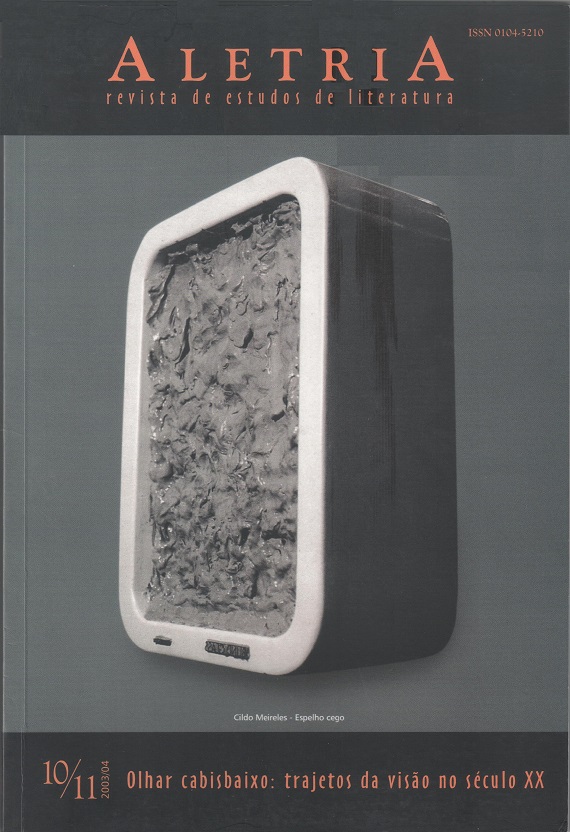The Visions of Orpheus in Milton's Lycidas
DOI:
https://doi.org/10.17851/2317-2096.10..126-143Keywords:
olhar, ponto de vista, Orfeu, Milton, gaze, viewpoint, Orpheus.Abstract
Resumo: As alusões ao mito de Orfeu em “Lycidas” de John Milton serão analisadas pela perspectiva de um signo relacional. Uma vez que o poema apresenta olhares opostos e diferentes incorporados no seu texto, a reescrita renascentista do mito de Orfeu será associada às mudanças de olhares, será acessada como a estrutura modeladora subjacente às transições entre um ponto de vista inocente e um ponto de vista iluminado e será pensada como uma tomada (fragmentada) de consciência no processo de definição de duas ordens de existência: a humana e a divina.
Palavras-chave: olhar; ponto de vista; Orfeu; Milton.
Abstract: In John Milton’s “Lycidas” the allusions to the Orpheus myth will be analyzed through the perspective of a relational sign. Since the poem has different and opposing gazes incorporated into the text, the Renaissance rewriting of the Orpheus myth will be associated with the changes of gazes, will be assessed as the modeling frame that underlies the transitions from an innocent to an enlightened viewpoint, and will be focused as the fragmented configuration of consciousness in the process of defining two orders of existence: the human and the divine.
Keywords: gaze; viewpoint; Orpheus; Milton.
Downloads
References
ABRAMS, M. H. Five Types of Lycidas. In: PATRIDES, C. A. (Ed.). Milton’s “Lycidas:” The Tradition and The Poem. New York: Holt, Rinehart, 1961. p. 212-235.
ADAMS, Richard P. The Archetypal Pattern of Death and Rebirth in Milton's Lycidas. PMLA, v. 14, p. 183-188, 1949.
ALPERS, Paul. Lycidas and Modem Criticism. ELH, v. 49, n. 2, p.468-496, Summer 1982.
BAKER, Stewart A. Milton's Uncouth Swain. In: SIMMONDS, J. D. (Ed.). Milton Studies 3. Pittsburgh: University of Pittsburgh Press, 1971. p. 35-53.
BLACKBURN, Thomas H. Lycidas: Eternity as Artifice. In: SIMMONDS, J. D. (Ed.). Milton Studies. Pittsburgh: University of Pittsburgh Press, 1992. v. 27, p. 79-93.
CAREY, John; FOWLER, Alastair. The Poems of Milton. London: Longmans, Green, 1968.
FOWLER, Alastair. “To Shepherd’s Ear”: The Form of Milton’s Lycidas. In: FOWLER, A. (Ed.). Silent Poetry. London: Routledge & Kegan Paul, 1970. p. 170-184.
FRIEDMAN, Donald M. Lycidas: The Swain’s Paideia. In: SIMMONDS, J. D. (Ed.). Milton Studies. Pittsburgh: University of Pittsburgh Press, 1971. v. 3. p. 3-34.
GUILLORY, John. Poetic Authority: Spenser, Milton, and Literary History. New York: Columbia University Press, 1983.
HOOKER, Richard. Lycidas and the Ecphrasis of Poetry. In: SIMMONDS, J. D. (Ed.). Milton Studies. Pittsburgh: University of Pittsburgh Press, 1992. v. 27. p.59-77.
JAY, Martin. Downcast Eyes: The Denigration ofVision in Twentieth-Century French Thought. Berkeley: University of California Press, 1994.
KAMINSKI, Thomas. Striving with Virgil: The Genesis of Milton's ‘Blind Mouths’. Modern Philology, v. 92, n. 4, p. 482-487, May 1995.
LANGDON, S. Tammuz and Ishtar. Oxford: Oxford University Press, 1914.
LAWRY, J. S. "Eager Thought": Dialectic in Lycidas. PMLA, v. 77, n. 1, p. 27-32, 1962.
LIEB, Michael. "Yet Once More": The Formulaic Opening of Lycidas. Milton Quarterly, v. 12, p. 23-28, 1978.
LIEB, Michael. Milton and the Culture of Violence. Ithaca: Cornell University Press, 1994.
MACCAFFREY, Isabel G. Lycidas: Poet in a Landscape. In: SUMMERS, J. H. (Ed.). The Lyric and Dramatic Milton. New York: Columbia University Press, 1965. p. 65-92.
MALLETTE, Richard. Spenser, Milton, and Renaissance Pastoral. Lewisburgh: Bucknell University Press, 1981.
MARTZ, L. Milton: Poet of Exile. New Haven: Yale University Press, 1986.
MAURO, Jason Issac. Engine Trouble in Milton's Lycidas. ELN, p. 25-30, June 1993.
MAYERSON, Caroline W. The Orpheus Image in Lycidas. PMLA, v. 14, p.189-207, 1949.
MCCOLLEY, Diane. Milton's Eve. Urbana: University of Illinois Press, 1983.
MILTON, John. Paradise Regained, The Minar Poems and Samson Agonistes. Ed. By M. Y. Hughes. New York: The Odyssey Press, 1937.
NIETZSCHE, Friedrich. The Birth of Tragedy from the Spirit of Music. In: ADAMS, H. (Ed.). Critical Theory Since Plato. New York: Harcourt Brace Jovanovich, 1971. p. 628-634.
PATTERSON, Annabel. Couples, Canons, and the Uncouth: Spenser-and Milton in Educational Theory. Critical Inquiry, v. 16, n. 4, p. 773-793, Summer 1990.
PATRIDES, C. A. "Something Like Prophetic Strain": Apocalyptic Configurations in Milton. In: MAJOR, J. et al. (ed.). Milton Essays and Reviews. ELN, March 1982. p. 193-207.
RANSOM, John Crowe. A Poem Nearly Anonymous (Lycidas). In: THORPE, J. (Ed.). Milton Criticism. London: Routledge & Kegan Paul, 1962. p.225-238.
REESING, John. Milton's Poetic Art. Cambridge: Harvard University Press, 1968.
SÁ, Luiz Fernando Ferreira. The Myth of Orpheus in Milton's L.Allegro, Il Penseroso, and Lycidas. Belo Horizonte: UFMG, 1996.
SHAWCROSS, John T. John Milton: The Self and the World. Lexington: The University Press of Kentucky, 1993.
SILVER, Victoria. Lycidas and the Grammar of Revelation. ELH, v. 58, p. 779-808, 1991.
TILLYARD, E. M. W. Milton. London: Longmans; Green, 1962.
TILLYARD, E. M. W. The Miltonic Setting. London: Chatto & Windus, 1966.
WITTREICH, Joseph A. Milton and the Line of Vision. Madison: University of Wisconsin Press, 1975.
Downloads
Published
Issue
Section
License
Copyright (c) 2003 Luiz Fernando Ferreira Sá (Autor)

This work is licensed under a Creative Commons Attribution 4.0 International License.
Authors who publish with this journal agree to the following terms:Authors retain copyright and grant the journal right of first publication with the work simultaneously licensed under a Creative Commons Attribution Non-Commercial No Derivatives License that allows others to share the work with an acknowledgement of the work's authorship and initial publication in this journal.Authors are able to enter into separate, additional contractual arrangements for the non-exclusive distribution of the journal's published version of the work (e.g., post it to an institutional repository or publish it in a book), with an acknowledgement of its initial publication in this journal.Authors are permitted and encouraged to post their work online (e.g., in institutional repositories or on their website) prior to and during the submission process, as it can lead to productive exchanges, as well as earlier and greater citation of published work (See The Effect of Open Access).









